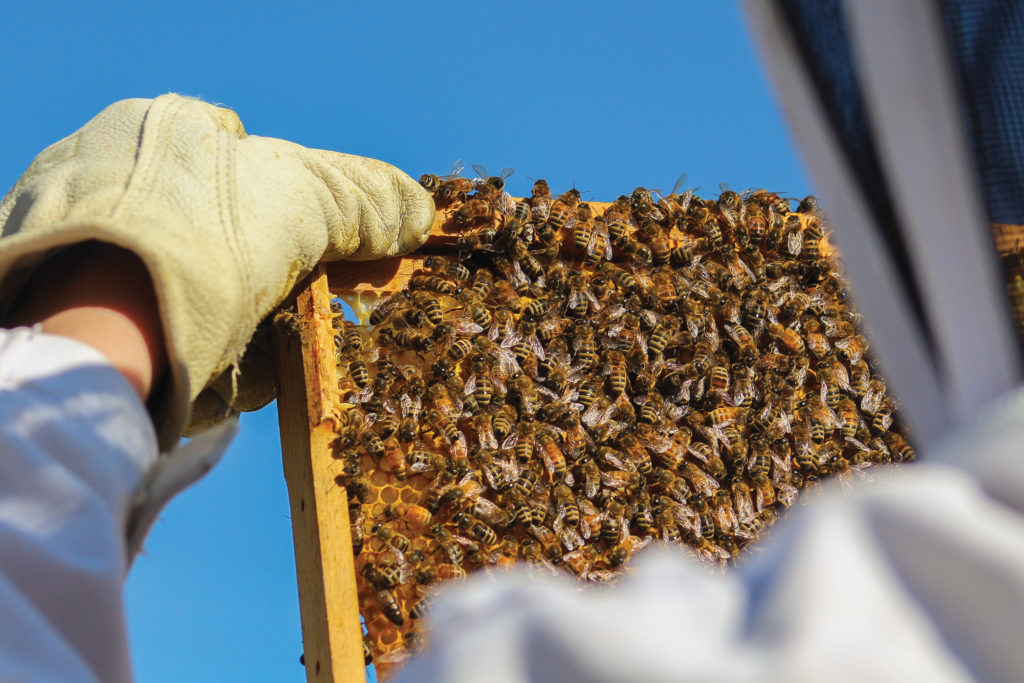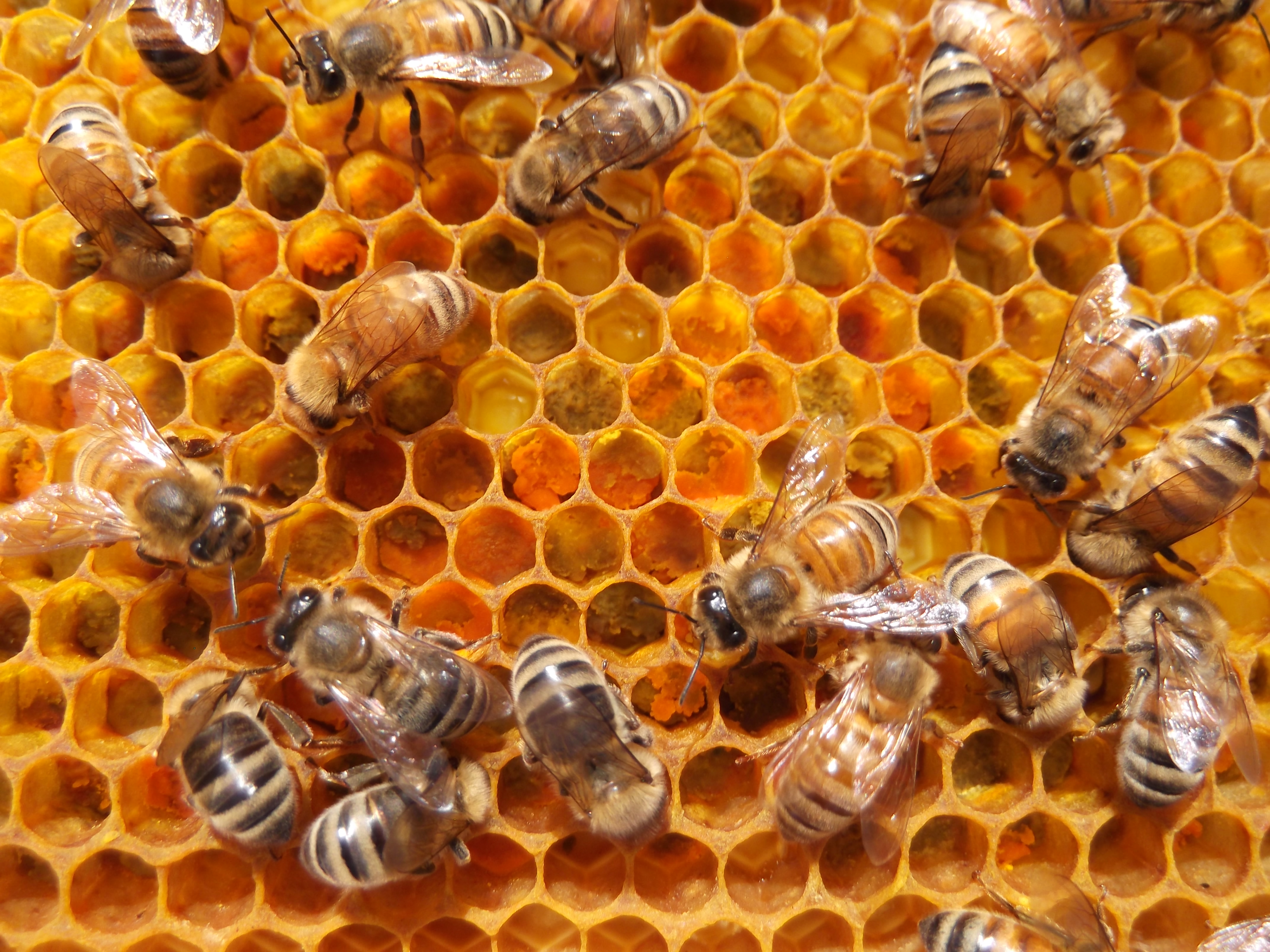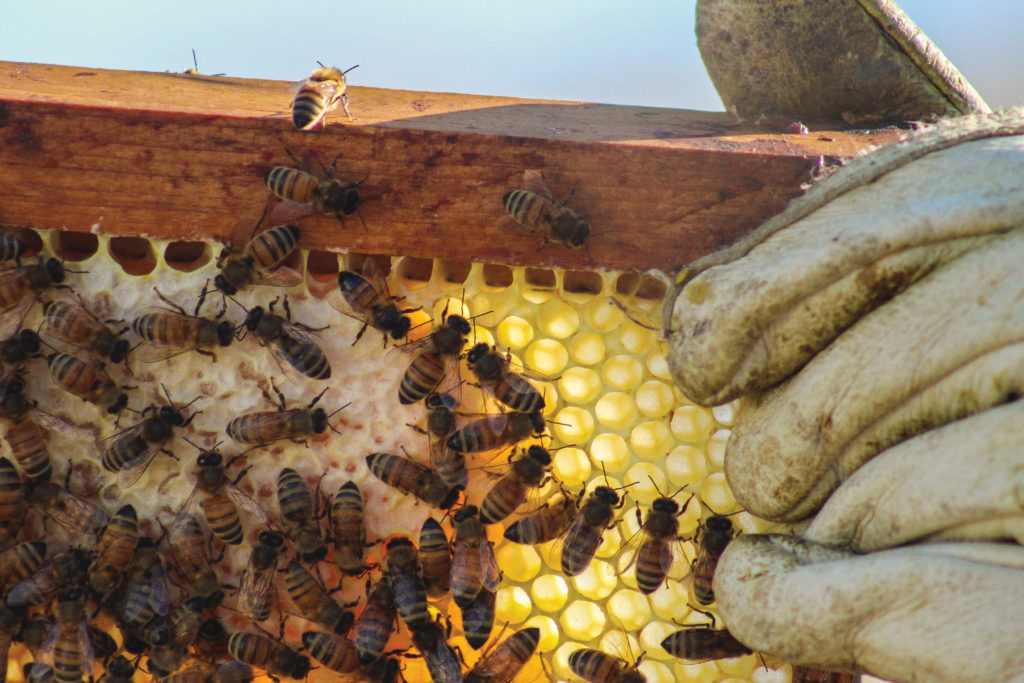As she walks across her yard Alison Tompkins can hear a familiar buzzing sound. It gets louder as she comes closer to the yellow and tan boxes. Attached to the hood of her white protective suit, a net covers her face. When she approaches she removes the lid from the hive, leather gloves cover her hands as the humming sound gets louder. The bees fly in and out, wandering around the edges of the wooden frames.
Due to environmental factors such as pesticides and varroa mites, bee populations across the country have been declining. As a result, over the past couple years there has been a large push to protect bees and other pollinators. Beekeepers and scientists are working hard to educate community members on the importance of pollinators and how to save the bees.

Beekeeping and Honey Production
A tall man with white hair and a goatee leans back and watches as crowds of people meander down the row of stalls. His hands rest inside of his dark yellow jacket, a logo reading DiggBee Honey on the front of it.
He remains quiet as a young couple approaches his table. They examine the rows of honey neatly arranged in front of him in an assortment of jars and little honey bears. He answers their questions when they ask, but the majority of the time he leans back and watches the crowd.
As the weather warms up, the Moscow Farmers Market will return soon, and local beekeepers like Robert Kunasek will be selling their honey. He started beekeeping several years ago, selling honey through his company DiggBee Honey at local markets like the Moscow Farmers Market.

“I majored in oceanography and I learned all about fish farming, but I never was able to get a job in fish hatchery,” Kunasek said. “I started learning about bees and I thought, ‘well that satisfies my curiosity.’”
One way Kunasek was able to channel this curiosity through the honey making process.
“I started thinking about how to get the best honey, and I thought ‘Well the bees all do the same work, it’s where you put the bees and the kind of plants that they’re working on’. So I look for blackberries and fruit,” Kunasek said.
Alison Tompkins, another beekeeper in the area, found her fascination with bees after her father began beekeeping himself. Tompkins maintains her hives in her backyard and occasionally sells honey, honeycomb and beeswax candles through her company Moscow Bee Co.
“I got into bees because of my dad”
“I got into bees because of my dad,” Tompkins said. “Once he retired he started beekeeping. He was interested in beekeeping because his dad was a beekeeper. My dad grew up in Houston and they were pretty poor. One of the ways that his dad was able to bring in extra money was by selling honey comb.”
Kunasek and Tompkins are both hobbyist beekeepers, meaning they work full time and tend to their hives as a hobby rather than as a career.
“This is not my main source of income,” Tompkins said. “I do other things, so I have more colonies than your average backyard beekeeper, but I don’t have enough to support myself. I generally have anywhere from a dozen to two dozen colonies.”
When he was starting out, Kunasek said he did a lot of research on bees and maintaining hives. Through trial and error, he began to find the best ways to maintain his hive, checking for varroa mites and other things that may harm the colony.
Tompkins and Kunasek said most of the work they do is monitoring and maintenance as the bees pollinate and create honey. Tompkins said she typically only opens the hives if the weather is good, and provides monthly maintenance.
“They have to do it all themselves, the really hard work comes when you’re either splitting hives or you’re harvesting,” Kunasek said. “You pretty much leave them alone and let them do what they do and if you disturb them too much they take a while to get their productivity back up.”
According to Tompkins, colony activity changes throughout the seasons and therefore maintenance also needs to change season to season. Throughout the year, bee activity changes and that can change what the colony looks like.
“What’s normal in spring isn’t what’s normal in August,” Tompkins said. “In spring, they’re building up brood numbers. In August you might search the whole hive and only find a little teeny single fist sized patch of brood.”
Brood | Noun – The eggs, larvae and pupae of bees.
A big thing beekeepers look for when maintaining hives are invaders that could harm their colonies such as varroa mites. “Varroa mites are a big deal,” Tompkins said. “There’s actually some very different schools of thought on what is the best way to deal with varroa mites. Everything from herbal remedies to chemical treatments.”
When Kunasek first started beekeeping he lost his colony to varroa mites, an issue he said he has since worked hard to prevent.
“I was trying to do all natural, let them take care of themselves,” Kunasek said. “I’ve come to learn that, you have to treat for mites, especially when you’re doing beekeeping because you have several hives in close proximity.”
Researching Pollinators
Brad Stokes grins ear to ear as he flips through PowerPoint slides of various bees native to Idaho. His eyes are full of excitement as he notes the details of each type of bee, from the big green eyes of one to the underground nesting habits of another.
Stokes, an entomologist working at the University of Idaho extension in Elmore County has spent a lot of time researching bees and other pollinators.
“I did my masters research in entomology insects,” Stokes said. “Then when I got this position, I realized that bees were a big concern in the scientific community. We’ve been reading around about colony collapse disorder (CCD) for a while and the preservation of our Idaho native bees so that’s kind of what got me involved.”
Through his research on CCD Stokes has found that there are many factors that cause the disease in bee colonies.

“It’s a synergistic problem combining several aspects of ecology, pesticides, lack of nectar resources, as well as passive honeybee colonies,” Stokes said. “There are hive beetles and wax smalls as well, so it’s this combination effect that leads to CCD as we understand it, that the disorder can really be a huge economic concern for beekeepers around the entire world.”
Currently, Stokes is working on another project that tracks bee populations in Elmore County. He started the project in 2018, tracking bee populations each month by type, and where they were found.
Colony Collapse Disorder | Noun
Also called CCD. Is a disease that causes majority of the worker bees to disappear from a hive.
“In 2018 I put out a bunch of traps around Elmore County, and the idea was to trap and document the pollinator species, specifically the bees in this case, that are present here so it’s documented in the future,” Stokes said. “I’m hoping to repeat this experiment in the summer of 2022 so we can actually measure if our bee species are declining, or increasing or staying the same.”
Using what he’s found through his research, Stokes aims to help the community better understand pollinators and how they help the environment, especially when it comes to learning more about the hundreds of species of native bees in Idaho.
“We have some absolutely beautiful bees in Idaho,” Stokes said. “A lot of people don’t realize that 70% of the our native bees are actually nesting under ground. That’s important as well, spreading the word about bees or pollinators in general.”
Stokes believes it is also extremely important to share the impact bees have on our environment. While honey bees produce honey, they are not native to Idaho. Native bee populations are important because they help pollinate local plants such as wildflowers.
“There’s some tight-knit relationships with some of our native Idaho wildflowers and other plant species,” Stokes said. “If the bees collapsed there might be a trophic cascade, we might lose some species of wildflowers or Idaho native plants.”
Supporting Pollinators
A clump of bees rests against the corner of a house, buzzing as they nestle together. Tompkins gently uses her gloved hands to scoop out the bees, searching for the queen, and places her in a safe container for the remainder of the colony to follow.
In addition to beekeeping, Tompkins receives calls to remove swarms of bees from people’s property.
By collecting swarms Tompkins helps protect the bees from being harmed by pesticides and other traps.

“I think one of the biggest misconceptions that I get calls about is people telling me that they have a swarm, when in fact they have an established colony living somewhere,” Tompkins said. “There’s a very big difference between a swarm, that’s just a cluster, you know, almost ready to grab versus an established colony with drawn comb, brood and honey.”
Tompkins said a swarm is a natural part of bee lifecycles. When the colony grows it continues to fill up the space and eventually needs to create a new colony.
“They have a pretty low chance of survival if they don’t find a good place to inhabit before winter,” Tompkins said.
Collecting swarms is just one of the many ways beekeepers help protect pollinators. There are many reasons why bee populations are declining including the use of pesticides.
Tompkins and Kunasek advocate for limited use of pesticides when they’re needed. They suggest using less and targeting specific problem areas as well as making sure not to spray plants that are blooming.
“Think of it like you would think of yourself if you were taking medication,” Tompkins said. “Don’t use a bazooka to treat something that only requires a very small amount of a very specific product.”
Stokes said certain pesticides and insecticides such as neonicotinoids are of particular concern as to how they affected bees. Neonicotinoids are a type of insecticide that have chemicals that act similar to nicotine.
“The real concern with these specific or the specific class of insecticides, is they’re systemic within the plant,” Stokes said. “They’re typically applied to the ground and then they’re soaked up by the plant through the xylem and the roots, and they get into the leaf tissue, the nectar and the pollen itself. So, even small amounts of these chemicals are bio magnified by bees.”
By educating the community about the importance of pollinators and the impact humans have on their populations, both beekeepers and scientists aim to protect local pollinators. Stokes has done this through a number of means including community events and aiding in the creation of protection policies. In 2020 Stokes was awarded the Pollinator Advocate Award through the North American Pollinator Protection Campaign.

“They select one candidate each year from the U.S. for this award, so it was a big national award for me, and a big win for extension and the University of Idaho,” Stokes said.
Advocating for pollinators isn’t just about saving the bees. Tompkins and Stokes explained the importance of protecting all pollinators whether that’s bees, monarch butterflies or any others.
“Supporting pollinators, not saving the bees”
“I always try to stress that it’s not just about honeybees, it’s about pollinators,” Tompkins said. “The European honeybee is not a native bee to the U.S., it’s important, it’s not a native species, we actually have a lot of native pollinators that are very effective pollinators. So I always encourage people to look at this from the standpoint of supporting pollinators, not saving the bees.”



